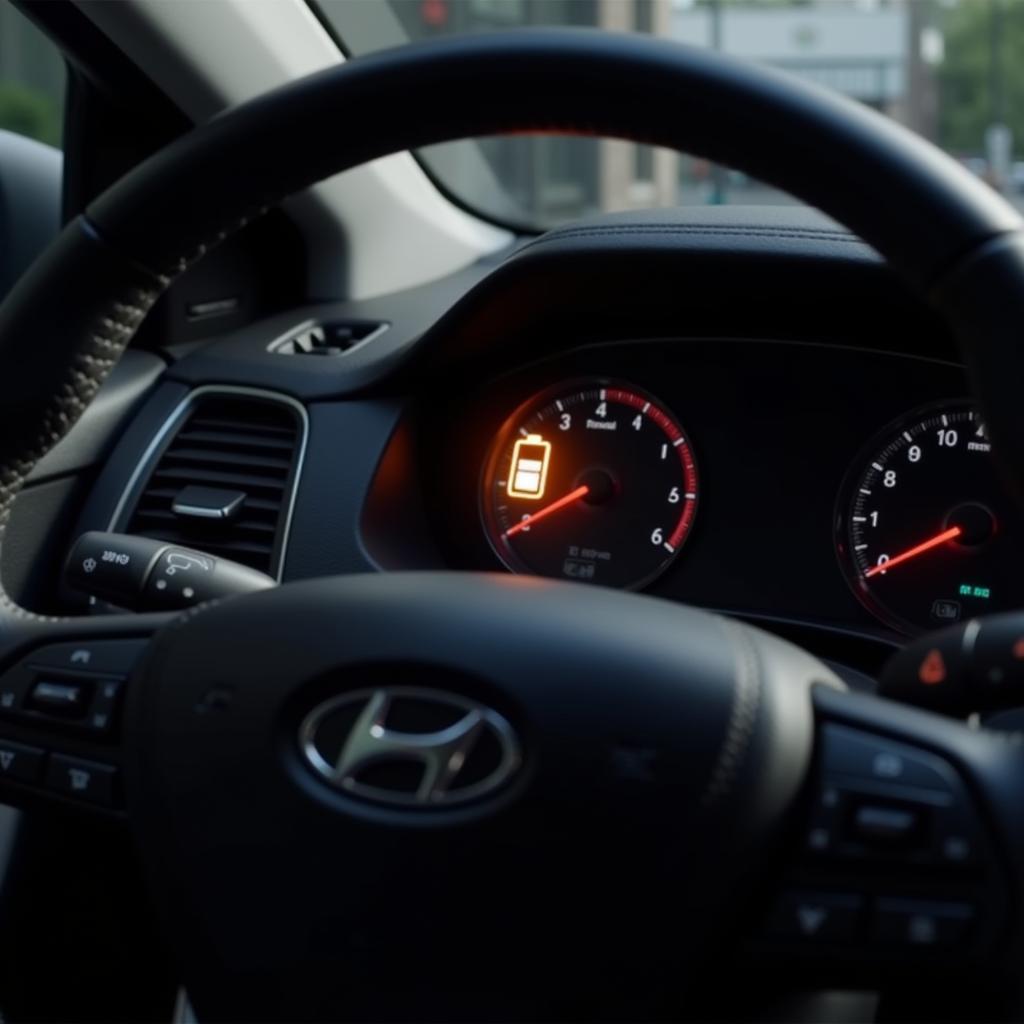The charging system warning light, often a battery icon, is a critical indicator of your car’s electrical health. If your charging system warning light comes on then off intermittently, it signals a potential problem that requires attention. Don’t ignore this flickering warning, as it can lead to more serious issues down the road. This guide will provide a comprehensive understanding of the causes, diagnostics, and solutions related to a charging system warning light that flickers on and off.
 Charging system warning light flickering on the dashboard of a car
Charging system warning light flickering on the dashboard of a car
Understanding the Charging System
Your car’s charging system comprises the alternator, battery, voltage regulator, and associated wiring. These components work together to provide power to your vehicle’s electrical systems and recharge the battery. When the warning light activates, it suggests a disruption in this delicate balance. Sometimes, the issue is intermittent, making it even more challenging to diagnose. Understanding how these components interact is crucial to pinpoint the root cause of the flickering warning light.
Like an android bluetooth car radio, the charging system is a complex network dependent on multiple parts functioning correctly. A failing component can trigger the warning light, especially if it only malfunctions intermittently.
Why is My Charging System Warning Light On Then Off?
Several factors can cause the charging system warning light to behave erratically. A loose or corroded battery cable is a common culprit. These connections can momentarily lose contact, causing the light to flicker. Similarly, a failing alternator can produce inconsistent voltage output, leading to the on-and-off illumination of the warning light.
Bad Alternator: A Frequent Offender
Often, a failing alternator is the primary cause. Alternators have internal components that can wear out, leading to intermittent function. This intermittent failure can be tricky to diagnose, as the alternator may test fine during periods of normal operation. Check out our guide on bad alternator vs bad battery symptoms for a more detailed explanation.
Loose or Corroded Battery Cables
Inspect your battery cables for any signs of corrosion or loose connections. Even a slightly loose cable can interrupt the flow of electricity, causing the warning light to flicker. Clean the terminals and tighten the connections to ensure proper contact. Sometimes, replacing the cables is necessary if the corrosion is severe.
Faulty Voltage Regulator
The voltage regulator controls the output of the alternator, ensuring a consistent voltage supply. A malfunctioning regulator can cause voltage fluctuations, triggering the warning light intermittently.
Diagnosing the Intermittent Charging System Warning Light
Diagnosing an intermittent issue requires patience and systematic testing. A multimeter can be a valuable tool in this process. Monitor the battery voltage while the engine is running. Fluctuations in voltage readings can indicate a problem with the alternator or voltage regulator.
Using a Multimeter: A Step-by-Step Guide
- Connect the red lead of the multimeter to the positive battery terminal.
- Connect the black lead to the negative terminal.
- Start the engine and observe the voltage reading. A healthy charging system should display a voltage between 13.5 and 14.5 volts.
- If the voltage fluctuates significantly or drops below 13 volts, it suggests a problem with the charging system.
What to Do When Your Charging System Warning Light Flickers
Ignoring a flickering charging system warning light can lead to a complete system failure, leaving you stranded. Address the issue promptly to avoid further complications. If you’re experiencing a flickering charging system warning light and considering an Honda Odyssey key fob battery replacement, it’s important to address the charging system first as it can affect other electrical systems in your car.
Seeking Professional Help
If you’re unsure about diagnosing or repairing the problem yourself, consult a qualified mechanic. They have the expertise and equipment to pinpoint the root cause and perform the necessary repairs.
Conclusion
A charging system warning light that comes on and off is a serious issue that shouldn’t be ignored. It signals a potential problem with your vehicle’s electrical system, which could eventually lead to a breakdown. By understanding the causes, diagnostic methods, and solutions outlined in this guide, you can take the necessary steps to resolve the issue and keep your car running smoothly. Don’t delay, address the issue promptly. If you’ve ever wondered can AutoZone program a key fob, remember that a fully functional charging system is essential for these types of operations. Additionally, if you are experiencing issues with your how to connect bluetooth phone to sony car radio, remember a flickering charging system warning light could indicate broader electrical problems that need to be resolved.
FAQ
- What does the charging system warning light look like? It typically resembles a battery icon.
- Can I drive with the charging system warning light flickering? It’s not recommended, as it could lead to a complete system failure.
- How much does it cost to fix a charging system problem? The cost varies depending on the specific issue and the labor rates in your area.
- Is it difficult to replace an alternator myself? It can be a moderately challenging DIY project, requiring some mechanical knowledge and tools.
- How long can I drive with a bad alternator? You might be able to drive for a short period, but the battery will eventually drain, and the car will stall.
- Can a bad battery cause the charging system warning light to flicker? While less common, a faulty battery can sometimes cause voltage fluctuations leading to a flickering warning light.
- What tools do I need to diagnose a charging system problem? A multimeter is the most essential tool for testing voltage and identifying issues.


